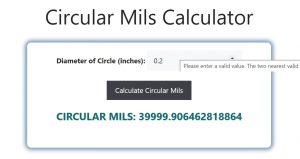About Circular Mils Calculator (Formula)
In electrical engineering, calculating the cross-sectional area of a wire is crucial for determining its current-carrying capacity. The cross-sectional area of a circular wire is typically measured in circular mils, a unit that simplifies calculations for wire sizing and design. Using a Circular Mils Calculator allows for quick and accurate determinations, ensuring the proper wire is selected for the specific electrical load.
Formula
The formula to calculate the cross-sectional area in circular mils is:
Area (A) = (π × D² / 4) / (7.854 × 10⁻⁷)
Where:
- A = Cross-sectional area in circular mils.
- D = Diameter of the wire (in inches).
How to Use
To use the Circular Mils Calculator:
- Measure the diameter of the wire in inches.
- Input the diameter into the calculator.
- Click Calculate Circular Mils to get the result, which will give you the cross-sectional area in circular mils.
Example
Let’s calculate the circular mil area for a wire with a diameter of 0.2 inches.
- Diameter (D) = 0.2 inches
Using the formula:
A = (π × (0.2)² / 4) / (7.854 × 10⁻⁷)
A ≈ 39,999.91 circular mils
Thus, the cross-sectional area of the wire is approximately 40,000 circular mils, as shown in the image.

FAQs
- What is a circular mil?
A circular mil is a unit of area used in electrical engineering to measure the cross-sectional area of round wires. - Why are circular mils important?
Circular mils simplify the calculation of wire sizes, which is important for ensuring that wires can safely carry the required current. - How do you calculate circular mils from wire diameter?
You calculate the cross-sectional area by squaring the diameter of the wire in inches and using the formula A = (πD² / 4) / (7.854 × 10⁻⁷). - What does the unit ‘mil’ stand for?
A mil is one-thousandth of an inch (0.001 inches), and it is used to describe the diameter of wires. - Can circular mils be used for non-circular wires?
No, circular mils are specifically for circular cross-sections. Other calculations are used for non-circular wires. - How do circular mils affect current capacity?
A wire with a larger cross-sectional area (in circular mils) can carry more current, making it suitable for higher loads. - How does wire diameter affect circular mils?
As wire diameter increases, the circular mil area increases proportionally, allowing the wire to carry more current. - Is there a difference between circular mils and square mils?
Yes, circular mils measure the area of circular cross-sections, while square mils measure square or rectangular areas. - What happens if you use a wire with too small a circular mil area?
Using a wire with a small circular mil area for a high current load can cause overheating, damage, or even fire. - How do you convert square inches to circular mils?
Multiply the area in square inches by 1,273,240 to convert it to circular mils. - What is the circular mil area of a 1-inch diameter wire?
A wire with a diameter of 1 inch has a cross-sectional area of 1,000,000 circular mils. - Why is calculating circular mils important for electrical safety?
Ensuring the proper wire size prevents overheating and potential hazards in electrical systems by using the correct capacity wires. - How do circular mils relate to wire gauge?
Wire gauges are determined based on the cross-sectional area of the wire in circular mils. Smaller gauge numbers indicate thicker wires. - How do environmental factors affect the circular mil requirement for a wire?
In higher temperature or harsher environments, wires may need larger cross-sectional areas to compensate for heat and ensure safe operation. - How are circular mils used in power transmission?
Circular mils help ensure that transmission lines are properly sized to handle the electrical load over long distances. - Can circular mil calculations be used for stranded wires?
Yes, for stranded wires, calculate the circular mil area of each strand and multiply by the number of strands. - What happens if a wire’s circular mil area is too large?
While using a larger wire won’t cause immediate problems, it may lead to unnecessary material costs and installation difficulties. - How does insulation thickness affect the circular mil calculation?
Insulation does not affect the circular mil calculation, which is based solely on the diameter of the conductive wire. - What industries commonly use circular mils for wire sizing?
Circular mils are commonly used in electrical, telecommunications, and power distribution industries for accurate wire sizing. - How can I ensure that I select the correct circular mil area for my wire?
Use the Circular Mils Calculator, along with current load guidelines and safety standards, to choose the correct wire size.
Conclusion
Understanding circular mils is essential for selecting the right wire size for electrical applications. Using the formula A = (π × D² / 4) / (7.854 × 10⁻⁷), you can easily calculate the cross-sectional area of a wire. The Circular Mils Calculator is a reliable tool for professionals in electrical engineering and ensures the wires you use are safe and efficient for your specific needs.
Related: